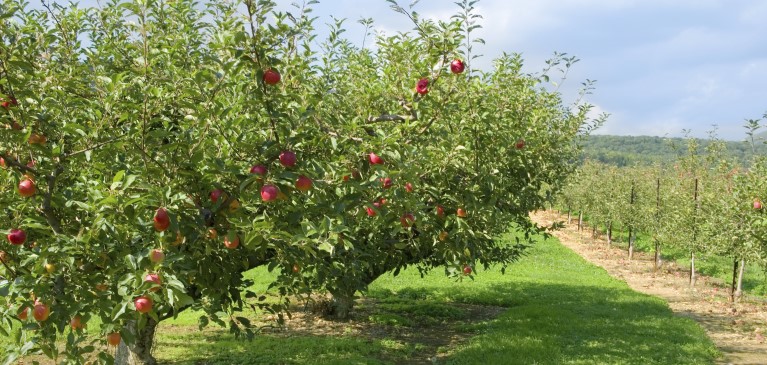
Michigan’s apple crop looks to be a beauty this year, both in quality and quantity, according to Dawn Drake, manager of Michigan Agricultural Cooperative Marketing Association’s (MACMA) Apple Division. She says the crop is estimated to be 27-28 million bushels, which is slightly above average for the state and up from last year’s 20 million bushels.
“We have an excellent quality crop this year and of pretty good size (fruit),” she says. “There was some concern with lack of moisture, but overall the crop has sized well.”
Up until recent rains, many growers were reporting dry to drought conditions. Yield will not be close to the bin-buster of 2013 – which followed the early spring/late frost year of 2012 that decimated the industry – but it looks optimistic.
Wisconsin is also seeing an increase in apple production, following an early freeze in 2016 that impacted yields. Production in 2017 was up 20 percent from 2016 to 49.0 million pounds, according to USDA, on the same 4,000 acres. Average yield per acre increased by 2,000 pounds to 12,300 pounds in 2017.
Mike Beck, a St. Johns ,Michigan grower with 80 acres of apples, says the crop looks pretty normal. “At first, we were way behind, but it’s caught up and yields look to be on par with a normal growing year,” he says. “Quality looks good to above average.”
He’s had a few fire blight strikes, but there’s more concern with the possible arrival and damage from the brown marmorated stink bug in August. The bug, first found in Michigan in 2010, is a voracious eater that damages fruit, vegetable and ornamental crops. It has become an increasing concern in the last few years.
“We don’t know if it’s going to be an issue or not,” Beck says. “Growers need to continue to scout.”
Going forward, making a living growing apples and other fruits will require producers to become even more efficient, according to Mark Longstroth, who has been a Michigan State University Extension Fruit Educator since 1993.
“In Grand Rapids, which has an excellent crop this year, growers are planting tall-spindle, high-density systems that lend themselves to mechanization,” he explains. “Growers can pack trees in 18 inches apart and grow up on a 10-to-12-foot tall trellis. There are no permanent branches off the trunks; they’re just short fruiting branches that they renew every few years. Orchards are being set up for mechanization, whether it be pruning, thinning or harvesting. Workers can ride through the orchards on platforms to do their work; they don’t have to move a ladder or walk.”
The most profit, he says, will come from these new systems, a market focus on fresh fruit and high-value new cultivars, including Sweet Tango, Jazz and others. As attractive as some of these new varieties are, Longstroth says access is limited to growers, who need to buy into a marketing ‘Club.’ These new varieties quickly become Club varieties where the rights to new varieties are bought by private marketing groups and licensed to a small group of growers to manage production and maintain high prices. The Club variety concept has had much success following the customer craze for Honey Crisp.
One counter measure has been the formation of the Midwest Apple Improvement Association, which started developing its own varieties, including EverCrisp. Members are not limited and can buy into the association to be granted access to the new varieties.
Another boost for the industry, Longstroth says, is the renewed interest in hard cider, which had strong demand before prohibition. It is opening new markets to compliment the already steady sweet cider market.
Pricing, yet to be predicted, is likely to be depressed as the state of Washington has a big crop, as do crops in the east, says Drake, who deals only with the marketing of processed apples.
The dance between supply and demand is an ongoing battle. “It’s a manageable crop, but a large national crop,” she says. “Customers think big crop, cheap prices,” she says. “Meanwhile, growers are seeing increased costs all around, including input costs and many have now gone to the (more expensive) H2A system for labor.”


